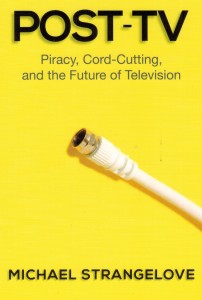Pat and Mike, two rival saloonkeepers on Main Street, were complaining of poor sales when they hit on a scheme. Pat took a dollar and went to Mike’s to buy a glass of beer, then Mike took the same dollar and returned the favour at Pat’s. On it went, Pat and Mike swapping the same dollar for beer. By month’s end both had phenomenal sales, and no income to refill their empty kegs.
So author Michael Strangelove hits on a peculiar analysis of what ails television. He complains media companies insist on charging for content to recover production costs while kids today just like free beer. “Free, easy, simple and feature-rich – this is not something that can be yanked out of consumers’ hands without a fight,” says Post-TV. Um, yes, but television, like beer, costs money to make. How would Post-TV suggest that television networks get cash to keep refilling the program schedule? The question does not interest Strangelove.
Post-TV documents an industry in transition. Thirty-nine percent of Canadians subscribe to Netflix and other unregulated internet TV services, according to the CRTC. They are still outnumbered by cable subscribers (47%), but the writing is on the wall: “The internet is transitioning into an alternative vehicle for watching television and movies,” Strangelove writes. “This in itself would not amount to much except that at the same time content and audiences are spiraling out of control. There are rumours and dire forecasts of the end of network broadcast television. There is the possibility that the internet will devastate the television and film industry in the same manner that it gutted the music industry.”
The phenomenon raises questions of federal regulation and the future of programming. Of Canadians under 34, the Netflix generation, only 28 percent tell the CRTC they consider “community programming” important. Internet TV is neat for watching Family Guy reruns, but who is left to cover the local school board? And if ad-sponsored network television is dead, where will media companies find the money to subsidize their news divisions?
Details, details, dismisses Strangelove, a lecturer at the University of Ottawa’s department of communications. He did not interview any TV executives for his book. The main fact worth noting is kids today “prefer to get their news online for free or from the Daily Show,” he writes.
“It is the changing habits of the young that are transforming the music, news and publishing sectors,” Post-TV insists; “The younger generation of internet users is the canary in the coal mine and will indicate if death is in the air for the incumbent television industry.”
It’s not, of course. Paid media remain the only reliable source for sports, news, documentaries and public affairs, the programming millions buy. More importantly, it remains the only means of meeting the cost of coverage. Netflix doesn’t interview school board trustees; YouTube doesn’t read the federal budget; and piracy remains a crime, though Strangelove celebrates theft: “The general trend has been towards the mass criminalization of everyday behaviour and increasingly draconian penalties for downloading something that is otherwise of marginal worth.”
There is something odd. Post-TV is not available for free on Strangelove’s website. The book is financed by taxpayers’ grants through the Canada Council For The Arts and still costs $28.48. It appears when you work as a university lecturer and heavily-subsidized author, you can opine on media economics and leave it to someone else to figure out how to fill the keg. Pat, meet Mike.
By Tom Korski
Post-TV: Piracy, Cord-Cutting, and the Future of Television, by Michael Strangelove; University of Toronto Press; 360 pages; ISBN 9781-4426-14529; $28.48






